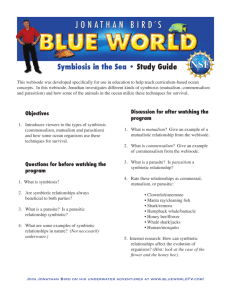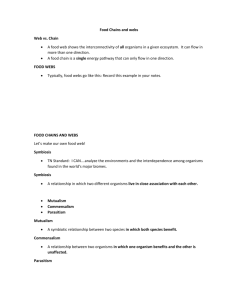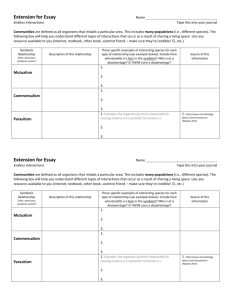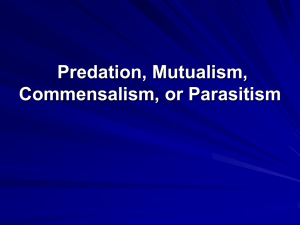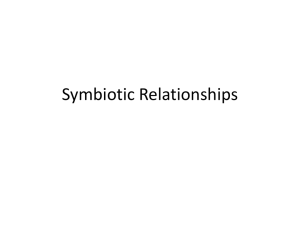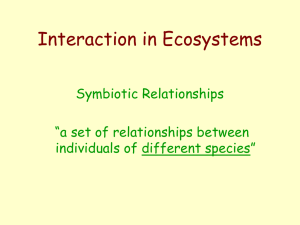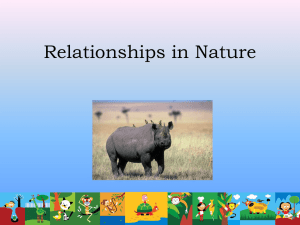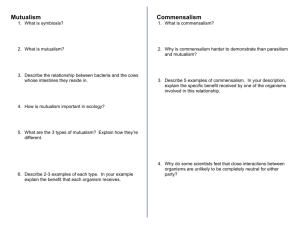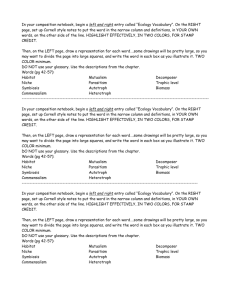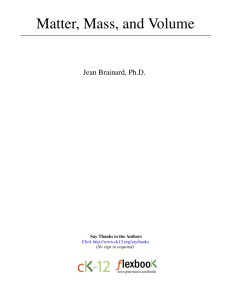Symbiosis
advertisement
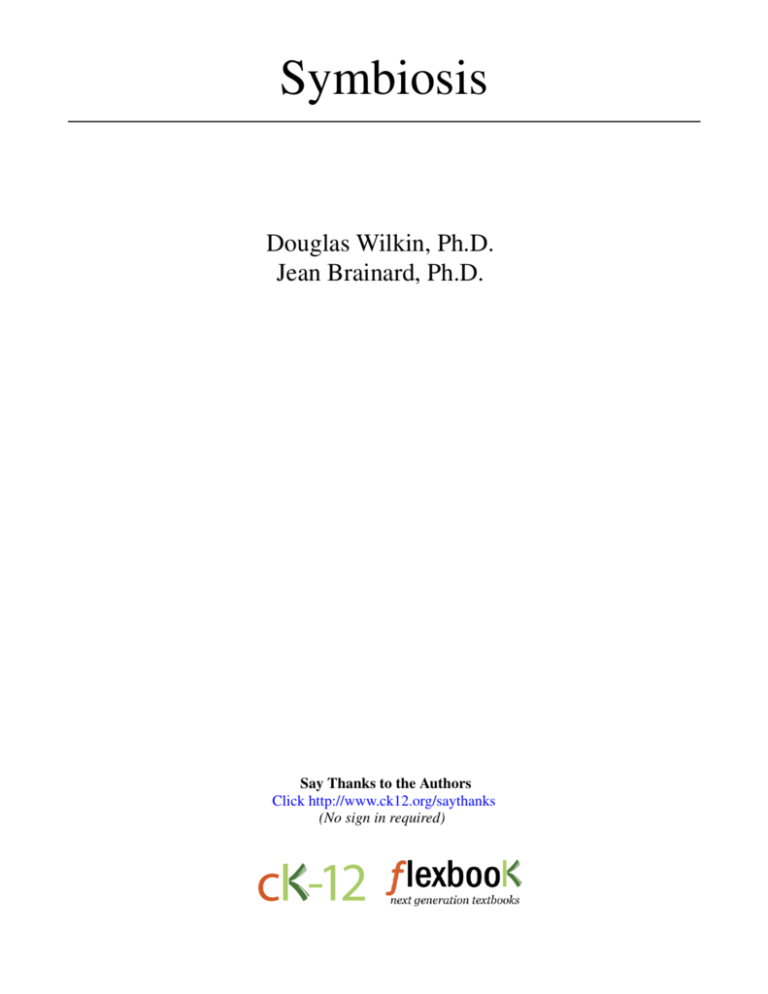
Symbiosis Douglas Wilkin, Ph.D. Jean Brainard, Ph.D. Say Thanks to the Authors Click http://www.ck12.org/saythanks (No sign in required) To access a customizable version of this book, as well as other interactive content, visit www.ck12.org CK-12 Foundation is a non-profit organization with a mission to reduce the cost of textbook materials for the K-12 market both in the U.S. and worldwide. Using an open-content, web-based collaborative model termed the FlexBook®, CK-12 intends to pioneer the generation and distribution of high-quality educational content that will serve both as core text as well as provide an adaptive environment for learning, powered through the FlexBook Platform®. Copyright © 2014 CK-12 Foundation, www.ck12.org The names “CK-12” and “CK12” and associated logos and the terms “FlexBook®” and “FlexBook Platform®” (collectively “CK-12 Marks”) are trademarks and service marks of CK-12 Foundation and are protected by federal, state, and international laws. Any form of reproduction of this book in any format or medium, in whole or in sections must include the referral attribution link http://www.ck12.org/saythanks (placed in a visible location) in addition to the following terms. Except as otherwise noted, all CK-12 Content (including CK-12 Curriculum Material) is made available to Users in accordance with the Creative Commons Attribution-Non-Commercial 3.0 Unported (CC BY-NC 3.0) License (http://creativecommons.org/ licenses/by-nc/3.0/), as amended and updated by Creative Commons from time to time (the “CC License”), which is incorporated herein by this reference. Complete terms can be found at http://www.ck12.org/terms. Printed: December 30, 2014 AUTHORS Douglas Wilkin, Ph.D. Jean Brainard, Ph.D. www.ck12.org C HAPTER Chapter 1. Symbiosis 1 Symbiosis • Define symbiosis. • Compare and contrast mutualism, commensalism, and parasitism. Do interactions between species always result in harm? A commensal shrimp sits on another sea organism, a sea slug. As a commensal shrimp, it neither brings a benefit nor has a negative effect on its host. Symbiotic Relationships Symbiosis is a close relationship between two species in which at least one species benefits. For the other species, the relationship may be positive, negative, or neutral. There are three basic types of symbiosis: mutualism, commensalism, and parasitism. Mutualism Mutualism is a symbiotic relationship in which both species benefit. An example of mutualism involves goby fish and shrimp (see Figure 1.1). The nearly blind shrimp and the fish spend most of their time together. The shrimp maintains a burrow in the sand in which both the fish and shrimp live. When a predator comes near, the fish touches the shrimp with its tail as a warning. Then, both fish and shrimp retreat to the burrow until the predator is gone. From their relationship, the shrimp gets a warning of approaching danger. The fish gets a safe retreat and a place to lay its eggs. Commensalism Commensalism is a symbiotic relationship in which one species benefits while the other species is not affected. One species typically uses the other for a purpose other than food. For example, mites attach themselves to larger flying insects to get a “free ride.” Hermit crabs use the shells of dead snails for homes. 1 www.ck12.org FIGURE 1.1 The multicolored shrimp in the front and the green goby fish behind it have a mutualistic relationship. Parasitism Parasitism is a symbiotic relationship in which one species (the parasite) benefits while the other species (the host) is harmed. Many species of animals are parasites, at least during some stage of their life. Most species are also hosts to one or more parasites. Some parasites live on the surface of their host. Others live inside their host. They may enter the host through a break in the skin or in food or water. For example, roundworms are parasites of mammals, including humans, cats, and dogs (see Figure 1.2). The worms produce huge numbers of eggs, which are passed in the host’s feces to the environment. Other individuals may be infected by swallowing the eggs in contaminated food or water. FIGURE 1.2 Roundworms like this one might eventually fill a dog’s intestine unless it gets medical treatment. Some parasites kill their host, but most do not. It’s easy to see why. If a parasite kills its host, the parasite is also likely to die. Instead, parasites usually cause relatively minor damage to their host. 2 www.ck12.org Chapter 1. Symbiosis Summary • • • • Symbiosis is a close relationship between two species in which at least one species benefits. Mutualism is a symbiotic relationship in which both species benefit. Commensalism is a symbiotic relationship in which one species benefits while the other species is not affected. Parasitism is a symbiotic relationship in which one species (the parasite) benefits while the other species (the host) is harmed. Explore More Use this resource to answer the questions that follow. • http://www.hippocampus.org/Biology ! Non-Majors Biology ! Search: Interactions Within Communities 1. 2. 3. 4. What are the three types of symbiotic relationships? Describe the three symbiotic relationships. Describe an example of a symbiotic relationship involving humans. Describe a symbiotic relationship involving plants and insects. Review 1. Define mutualism and commensalism. 2. Give examples of mutualism. 3. Explain why most parasites do not kill their host. Why is it in their own best interest to keep their host alive? References 1. User:Haplochromis/Wikimedia Commons. A shrimp and green goby fish have a mutualistic relationship . Public Domain 2. Image copyright Carsten Medom Madsen, 2014. Roundworms are a parasite in a dog’s intestine . Used under license from Shutterstock.com 3
